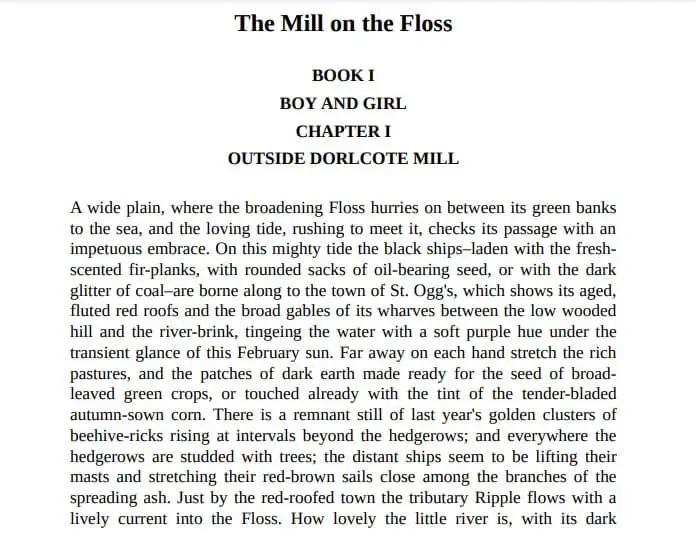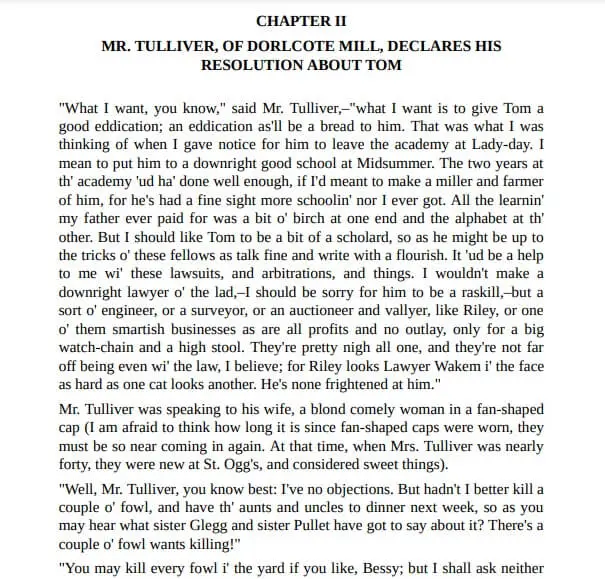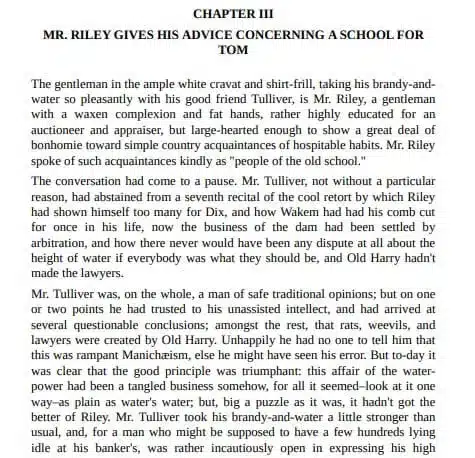Introduction
George Eliot’s The Mill on the Floss PDF is a cornerstone of 19th-century literature. It’s not just a tale of familial bonds and personal struggles but also a reflection of societal norms and expectations in the Victorian era. Written with remarkable depth and empathy, Eliot’s novel continues to resonate with readers today.
| Name of PDF | The Mill on the Floss |
|---|---|
| No Pages | 664 |
| Author | George Eliot |
| Originally Published | 1860 |
| Language | English |
| Genres Characters | Fantasy Fiction, Novel, Psychological Fiction, Domestic Fiction, Fictional Autobiography Mr Tulliver, Maggie Tulliver, Tom Tulliver, Mrs Bessy Tulliver, Stephen Guest, Philip Wakem |
| Size | 1.85 MB |
| Chek, latest edition |
Table of Contents

The Author Behind the Masterpiece
Who Was George Eliot?
George Eliot, born Mary Ann Evans in 1819, was a trailblazing author who defied societal conventions by writing under a male pseudonym. This decision was driven by her desire to ensure her works were taken seriously in a male-dominated literary world.
A Revolutionary Female Author
Eliot challenged the norms of her time, writing deeply psychological novels that addressed complex themes like morality, religion, and societal expectations.
Synopsis of The Mill on the Floss
Setting and Context
The story unfolds in the fictional village of St. Ogg’s, centered around the River Floss and Dorlcote Mill. The river, with its ceaseless flow, becomes a symbol of life’s unpredictability.
The Tulliver Family
The narrative revolves around the Tulliver siblings, Maggie and Tom, whose lives are deeply intertwined with the mill. Their contrasting personalities drive much of the story’s conflict.
Thematic Exploration
Family and Relationships
At its heart, the novel explores the bond between Maggie and Tom. Their sibling love, marred by misunderstandings and societal pressures, is both heartwarming and tragic.
Gender and Society
Maggie’s journey reflects the constraints placed on women during the Victorian era. Her desires for intellectual freedom and emotional fulfillment clash with societal expectations.
Conflict and Morality
Eliot delves into the complexities of moral dilemmas, illustrating how personal choices are often at odds with societal judgments.
Key Characters
Maggie Tulliver
Maggie’s intelligence, emotional depth, and rebellious spirit make her one of Eliot’s most memorable characters. Her struggles against societal norms are poignant and relatable.
Tom Tulliver
Tom’s loyalty to his family contrasts with his rigid moral code, often leading to tensions with Maggie.
Philip Wakem
Philip, a sensitive and intellectual character, highlights themes of love, forgiveness, and societal prejudice.

Literary Devices and Style
Use of Symbolism
The River Floss is not just a backdrop but a metaphor for life’s turbulent journey, representing both destruction and renewal.
Narrative Techniques
Eliot’s omniscient narration allows readers to delve deep into the characters’ psyches, offering profound insights into their motivations.
The Reception of The Mill on the Floss
Initial Critical Reception
While some Victorian critics praised the novel’s realism, others were uncomfortable with its unconventional themes and tragic ending.
Modern Perspectives
Today, the novel is celebrated for its rich characterizations and exploration of gender and morality. It remains a staple in literary studies.
Impact on Literature
Influence on Feminist Literature
Maggie Tulliver’s character has been hailed as a precursor to feminist protagonists, inspiring countless authors.
Contribution to Realism
Eliot’s meticulous portrayal of rural life and human emotion cemented her status as a pioneer of literary realism.
Conclusion
The Mill on the Floss is more than just a novel; it’s a timeless exploration of human relationships, societal constraints, and personal struggles. Through Maggie Tulliver, George Eliot offers a poignant critique of Victorian society, making the novel a must-read for anyone interested in classic literature.

FAQs about The Mill on the Floss PDF
What inspired George Eliot to write The Mill on the Floss?
Eliot drew inspiration from her own childhood experiences and her relationships with her family.
Why is the River Floss significant in the novel?
The river symbolizes life’s uncontrollable forces, shaping the characters’ fates.
How does The Mill on the Floss reflect Victorian society?
The novel highlights societal expectations, gender roles, and class struggles prevalent in the Victorian era.
Is Maggie Tulliver based on George Eliot’s life?
While not autobiographical, Maggie shares traits with Eliot, such as intelligence and a thirst for knowledge.
Why is The Mill on the Floss considered a classic?
Its timeless themes, rich characterizations, and masterful storytelling ensure its enduring relevance.
Is The Mill on the Floss a good novel?
Considered George Eliot’s most autobiographical nove
Is Mill on the Floss a love story?
In many ways, The Mill on the Floss is a silly romantic story
What is the concept of The Mill on the Floss?
Explores themes of gender and class, as well as the tension between individual desires and societal expectations.





